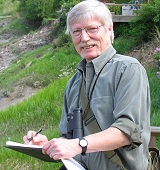

David Mead
| About the Artist |
David Mead’s love of nature began in his boyhood, amid the beechwoods and farmlands of the Chiltern Hills in southern England.
Birds quickly captured his imagination, and he began studying and painting them. In 1979, he gave up a career in journalism to work full-time as a wildlife artist and freelance writer.
He undertook artwork commissions for many publications and organisations, including the Royal Society for the Protection of Birds, BirdLife International, the Wildfowl and Wetlands Trust, and the World Pheasant Association.
As a result of exhibitions, his paintings are in private collections in the UK, Europe, USA, Canada, Australia and New Zealand.

He used gouache or watercolour for most of his book illustrations, but also worked in other mediums, including pastels and oils.
David lived with his wife Jo and two sons in a village in Devon, southwest England. It’s an area rich in wildlife habitats, close to the magnificent cliffs of the Jurassic Coast World Heritage Site. A perfect place for birds and bird artists alike!
Painting Raptors |
In a project spanning more than four years, David Mead produced 31 colour plates depicting all species of sparrowhawks, goshawks, kites and fish-eagles for Raptors of the World, published by Christopher Helm. The task involved painting a total of some 600 bird images.
David was always inspired by raptors and the wild landscapes they inhabit. But for all his field experience, he needed to undertake a huge amount of research to ensure the degree of accuracy required for the book.
Working with study skins at the Natural History Museum’s Bird Department at Tring, north of London, he took up to 50 measurements per skin to achieve the correct proportions, shapes and plumage markings. Colour sketches were made at the museum, and ornithologists around the world were contacted for further information on little-known species.
Equipped with as many references as possible, David prepared scaled drawings on tracing paper. Then came the ‘jigsaw’ stage: arranging individual images to create a layout design that was both practical and aesthetically pleasing. Once the pieces were in place, the pencil outlines were transferred to an eggshell-like painting surface, made by applying coats of tinted acrylic gesso. The birds were painted in gouache (opaque watercolour).
Including research time, each plate took around six weeks to complete.
| Painting Gamebirds |
Following his work on Raptors of the World, David Mead produced ten colour plates for the Helm identification guide, Pheasants, Partridges & Grouse.
The gallinaceous gamebirds (Galliformes) were among David’s favourite subjects, despite the long hours it takes to paint the countless speckles on some species.

Whilst working on this project, he was privileged to visit the aviaries of World Pheasant Association (WPA) members, many of whom take part in carefully managed captive breeding programmes to help safeguard threatened species.
David assisted in conservation work by producing illustrations for WPA publications, and by serving on the Partridge, Quail and Francolin Specialist Group of IUCN, the World Conservation Union.
He studied as many live birds as possible for the identification guide, and obtained further details from museum skins.
The plates in this book are on plain white paper backgrounds, which enabled David to use transparent watercolour as well as gouache for the artwork.